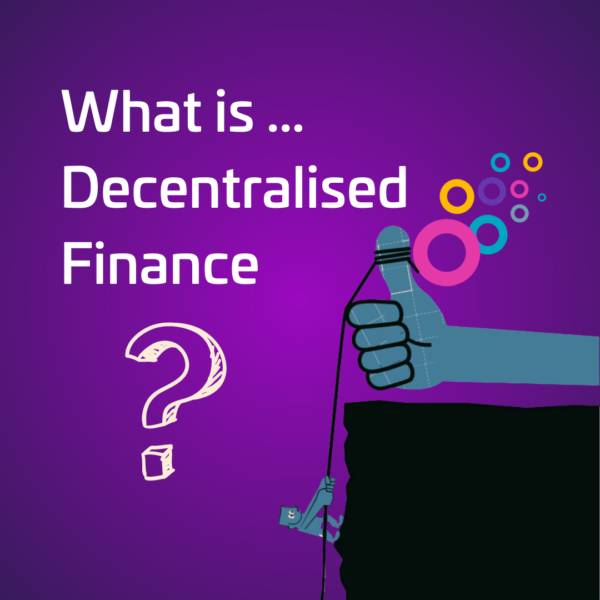
What is decentralised finance? Our team help you understand what decentralised finance is, why it exists, where it exists, and how to participate.
You’ve probably heard of decentralised finance – or defi – which involves recreating traditional financial products and services on the blockchain. But what exactly does defi involve? And more to the point, should you get involved?
In this guide, we’ll run through the fundamentals of decentralised finance: why it exists, where it exists, and how to participate, should you decide you wish to dabble in defi.
Defi: The Promise
While decentralised finance is often assigned the mission of trying to “bank the unbanked,” the reality is more nuanced. It’s true that no credit score, identity checks, or documentation are required to interact with defi protocols, but its primary users are very much plugged in to the global financial system. Less Kenyan coffee farmers and more Western millennials, in other words. Make no mistake, defi – like crypto – is open to anyone, regardless of race, gender, or geography. So far, however, its adopters have predominantly hailed from tech-savvy developed nations.
With defi, you won’t be discriminated against based on your wealth, nationality, or orientation. Provided you have access to an internet-connected device, and the means to purchase cryptocurrency, you’re eligible to participate in the decentralised finance economy. But what, exactly, does this economy resemble – and why is it generating so much fanfare?
Defi: The Reality
Decentralised finance is a movement focused on providing services once synonymous with traditional finance (think banks, insurers, and brokers) onchain. Blockchains are sometimes described as permissionless, which means that anyone can use them to send and receive funds and interact with crypto platforms.
Defi takes this ability and builds financial products and services on top of it. These decentralised platforms abstract most of the complexity of interacting with blockchain by overlaying a user interface that resembles a digital banking app. In just a few clicks, you can start trading, saving, lending, borrowing and earning interest on your crypto assets – and it’s all executed on the blockchain, allowing you to effectively be your own bank.
As former BitMEX CEO Arthur Hayes explains it, “Defi projects allow people to easily borrow directly from other individuals, who lend out their money in exchange for rewards that are built into the network. This has massive implications for the future of lending: no credit check, personal data, or bank account is required.
“Everyone can participate, and the lending terms are enforced by smart contracts that cannot be tampered with – removing the need for a trustworthy middleman.”
Using defi protocols, you can:
- Use your crypto assets as collateral to borrow stablecoins
- Earn interest for lending your crypto assets to other users
- Store money in digital savings accounts that pay high interest
- Trade tokens such as ETH and USDT
- Grow your wealth through liquidity mining and yield farming
The most popular blockchain for hosting decentralised finance applications is Ethereum. If you’re a Zumo app user, you likely hold its native currency, ETH, in your wallet. This same ETH forms the fuel that pays for defi transactions, or which can be locked into liquidity pools to earn rewards.
Defi users typically send ETH to a browser-based web wallet such as MetaMask. From there, they can connect to the website of any defi platform they like and interact with its smart contracts to implement tasks like lending and trading.
Explaining how to interact with defi protocols is beyond the remit of this guide: that’s another lesson in its own right. What’s more, since decentralised finance requires a degree of technical knowledge, you’re best not to rush in until you know what you are doing and fully understand the risks.
Defi: The Future
Just know this much: decentralised finance is a movement that has come of age and which is not going away. As the design of defi apps improves, and better fiat gateways are added to make onboarding easier, adoption is only going to soar. Right now, around $45 billion of crypto assets are staked in defi protocols, up from $600 million only a year ago. That’s a 75x increase.
The beautiful thing about defi is that it provides a way to make your money work for you. While there’s nothing wrong with purchasing ETH and simply storing it in your wallet, the cryptocurrency can unlock so many more opportunities.
If defi fulfils its potential, billions of people will one day be using decentralised applications to manage their money, their data, and their identity. At this stage in its lifecycle, defi is still a little rough around the edges, and remains the preserve of early tech adopters. Just as the internet was slow and unsightly to begin with, however, defi is only going to get better. When it does, the opportunities for wealth generation and global finance – without barriers or boundaries – will become too great to resist.

